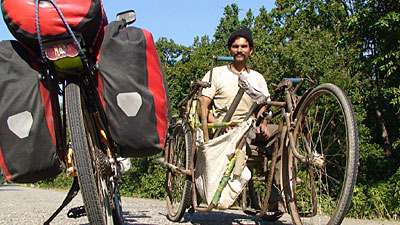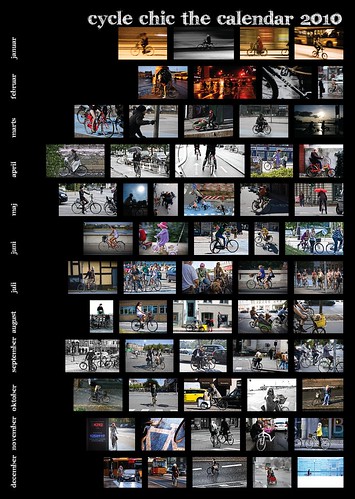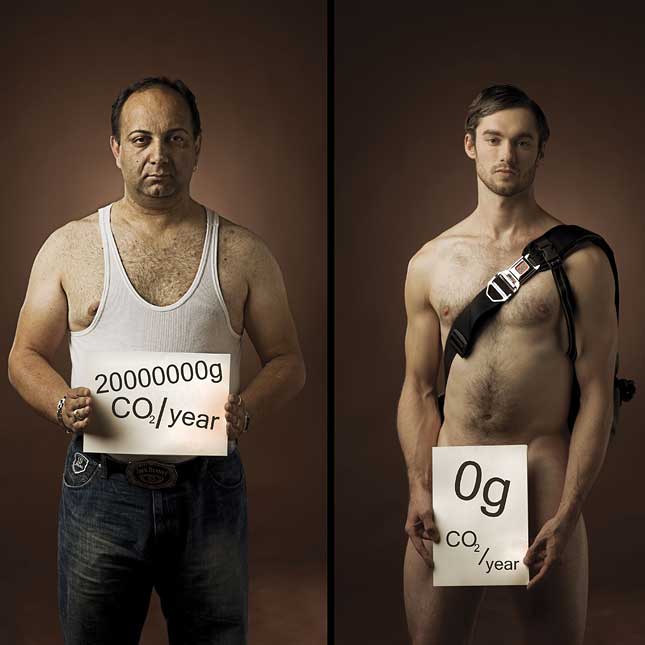Did you ever wonder about how much power media has on our lives/mobility? I will examine this power now for print media in Austria, but it also applies to TV stations, radio etc. Please note that I will just try to give some good and bad examples of newspaper articles related to cycling and maybe one should not extrapolate from that to general statements, although it might be tempting.
Negative publicity:
Last year, around the same time, there was an article in the Kurier (an Austrian-wide newspaper) that upset many people who use their bikes on a regular basis. They claimed that cyclists in the winter are simply irresponsible and stupid. I translated and summarized the content of the article earlier, see "Is cycling in the winter dangerous?" if you're interested in the details.
An even worse article is "Radlerdemo endet in Randale" ("Bike demonstration ends in riots") in the Österreich newspaper in 2007. It accussed the participants of the Halloween critical mass of damaging cars despite lack of any police evidence. I personally was there, and did not observe any misbehavior.
I also consider an article about traffic controls in Vienna in the Krone newspaper as rather negative. It mentions the fact that more and more cyclists and pedestrians get injured and killed these days and that the authorities try to countersteer this. However, their main message was that cyclists often do not obey the traffic rules and implicitly it's their own fault when they are run over by car drivers.
Useless advertising:
Ever seen a bicycle promoted in a newspaper ad? No? Well, sometimes there are ads by sport outfitters (only chains though) that want to sell cheap and crappy mountain bikes. This phenomena is closely related to the spring sell of shitty bikes by food chains, and only addressed to people who -- once a year -- have a wasteful desire to work on their body (I wrote about it last March). These bikes are mostly used once and then rot in a corner. That's why I consider these type of ads rather useless or even counterproductive for a bicycle culture as such.
The above is, on the other hand, accompanied by all these commercials that want to sell us cars. They are everywhere -- in newspapers, on the radio, the TV, on billboards, on flyers, in lotteries, in subway stations and trams. Lately I even came across a car advertised in a showcase at the Danube canal bike path. It's hard to ignore them. Very often they also sneak into usual newspaper articles. I'm sure you are aware of certain "car sections", but have you ever seen a "bicycle section" or a "train section"? I believe there is also some money involved. Or our society has been completely brainwashed already.
Positive publicity:
Yes, there are positive examples. The fact that the Standard became my favorite newspaper probably was not out of the blue. Alright, as every other newspaper they also promote cars and have a car section every Saturday. But they also print bike-related positive articles, and recently even established regular columns on bicycles, cyclists and cycling. For German speaking people I highly recommend the so-called Radkasten by Thomas Rottenberg and various bike stories by Guido Gluschitsch in the Automobil section. By now their articles get more comments than all these car-related ads which, in my humble opinion, clearly shows the need for more positive bike stories in Austria's media landscape. The started to fill a gap that was unknown to be a gap to most people.
Besides, it's not only their stories that attract me. It's the general design of their newspaper. They often just sneak in pictures of cyclists in everyday life. Let it be bike racks when they talk about the cold and snowy weather, a chic cyclist on the ring bike path (opposite of the parliament) when they remark that there is still no photovoltaic plant on the parliament's roof, a cyclist walking his bike along a road that has been closed down due to a water mains burst or a heavily loaded Chinese bicycle when they investigate Asia's economy.
Of course, the Standard is not the only example of positive bike publicity. I should certainly mention, e.g., the Falter and Presse as newspapers that have an objective or positive view on cycling in general. I particularly like an article by Sibylle Hamann (editor for Profil) in the Presse about cycling, traffic and the interaction of people. Very clear and neutral. Read her article here: "Radfahrkunde für Anfänger".
Well, I simply love positive medial coverage of cycling! Or neutral articles in the first place. I started my own collection of some interesting (so far only German) newspaper articles in a flickr album.
Of course I'm eager to find more articles and am grateful for comments in case you spot some interesting ones :). Someone might even want to examine the media landspace with regard to mobility (as it has already been done for articles on foreigners and other minorities). Could be a very interesting topic for some socio-scientific research.
Negative publicity:
Last year, around the same time, there was an article in the Kurier (an Austrian-wide newspaper) that upset many people who use their bikes on a regular basis. They claimed that cyclists in the winter are simply irresponsible and stupid. I translated and summarized the content of the article earlier, see "Is cycling in the winter dangerous?" if you're interested in the details.
An even worse article is "Radlerdemo endet in Randale" ("Bike demonstration ends in riots") in the Österreich newspaper in 2007. It accussed the participants of the Halloween critical mass of damaging cars despite lack of any police evidence. I personally was there, and did not observe any misbehavior.
I also consider an article about traffic controls in Vienna in the Krone newspaper as rather negative. It mentions the fact that more and more cyclists and pedestrians get injured and killed these days and that the authorities try to countersteer this. However, their main message was that cyclists often do not obey the traffic rules and implicitly it's their own fault when they are run over by car drivers.
Click on the pictures for enlargement
Useless advertising:
Ever seen a bicycle promoted in a newspaper ad? No? Well, sometimes there are ads by sport outfitters (only chains though) that want to sell cheap and crappy mountain bikes. This phenomena is closely related to the spring sell of shitty bikes by food chains, and only addressed to people who -- once a year -- have a wasteful desire to work on their body (I wrote about it last March). These bikes are mostly used once and then rot in a corner. That's why I consider these type of ads rather useless or even counterproductive for a bicycle culture as such.
The above is, on the other hand, accompanied by all these commercials that want to sell us cars. They are everywhere -- in newspapers, on the radio, the TV, on billboards, on flyers, in lotteries, in subway stations and trams. Lately I even came across a car advertised in a showcase at the Danube canal bike path. It's hard to ignore them. Very often they also sneak into usual newspaper articles. I'm sure you are aware of certain "car sections", but have you ever seen a "bicycle section" or a "train section"? I believe there is also some money involved. Or our society has been completely brainwashed already.
Positive publicity:
Yes, there are positive examples. The fact that the Standard became my favorite newspaper probably was not out of the blue. Alright, as every other newspaper they also promote cars and have a car section every Saturday. But they also print bike-related positive articles, and recently even established regular columns on bicycles, cyclists and cycling. For German speaking people I highly recommend the so-called Radkasten by Thomas Rottenberg and various bike stories by Guido Gluschitsch in the Automobil section. By now their articles get more comments than all these car-related ads which, in my humble opinion, clearly shows the need for more positive bike stories in Austria's media landscape. The started to fill a gap that was unknown to be a gap to most people.
Besides, it's not only their stories that attract me. It's the general design of their newspaper. They often just sneak in pictures of cyclists in everyday life. Let it be bike racks when they talk about the cold and snowy weather, a chic cyclist on the ring bike path (opposite of the parliament) when they remark that there is still no photovoltaic plant on the parliament's roof, a cyclist walking his bike along a road that has been closed down due to a water mains burst or a heavily loaded Chinese bicycle when they investigate Asia's economy.
Well, I simply love positive medial coverage of cycling! Or neutral articles in the first place. I started my own collection of some interesting (so far only German) newspaper articles in a flickr album.
Of course I'm eager to find more articles and am grateful for comments in case you spot some interesting ones :). Someone might even want to examine the media landspace with regard to mobility (as it has already been done for articles on foreigners and other minorities). Could be a very interesting topic for some socio-scientific research.

































